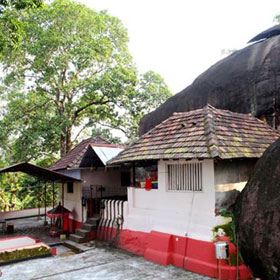
Kallil cave temple stands as a magnificent testimony to the mode of worship that was prevalent in ancient Kerala. This, literally a stone temple – or kallambalam in colloquial – is situated on a hillock, far from the madding urban mayhem in a serene village called Methala. Imagine a temple in a giant monolith – atone which is apparently suspended in air with no visible foothold on to the rarth below. The sculptures seen in the temple and the peculiar worship modalities throes light to the vivid cultural scheme prevalent in this land over thousands of years ago.
The abode of blessing is a fitting destination for those seeking solace, being caught in the strenuous cycle of modern day living. Bhagavathi who bask in the serene and picturesque natural milieu is mother to all who smiles forever upon her devotees and is ever ready to heed to their prayers grand their wishes. It is her benevolence that attracts her devotee again and again to this pristine spot.


Kallil hill that stations the temple and the surrounding locale are blessed with the country of natural splendor. Pulluvazhi and Keezhillam in MC Road and Kuruppampadi and Odakkaly on the Aluva – Munnar road serves as easy access to the temple. The 28 acre land surrounding the temple used to be an uninhabited forest. The temple and the adjoining lands belonged to the erstwhile powerful Kallil Pisharom. The exquisiteness of the backdrops attracts the seekers of both spiritual wellness and history. Like many other temples, this also used to be a Jain worship spot. The presence of Vardhamaana Mahavir , Paarshwanadhan and Padmavathi devi as deities serves as evidence to this historic piece of information. Perhaps the place where the Jain ‘Sanyaasis’ performed the ‘thapasya’ eventually became a temple in the course of time. This is said to have become a Hindu temple in the 9th century AD. Even today Jain followers come here to offer prayers.
The spectacle of the hovering massive stone that forms the roof of the shrine gives the temple its divine stature. There are many legends about how this state of the stone came into being. Once, people gathering forest resouces in the then dense forest came to see a divinely beautiful lady toying with huge stones. They were curious to know who this was, but in fraction of second this lady hid herself in the cave forming a cover with the stones she was playing with. The lady was none other than Kallil Bhagavathi. The stone that went up became the roof and the one fallen down became the seat of the Goddess.
The festival falls on the Karthika of month Vrishchika and lasts for a week. Unique enough, a female elephant is used as Devi’s convey on these days. It is quite a scene to witness the ‘Pradakshinam’ through the intricate pathway with the amazing illumination forming a befitting accomplice to the whole course of action.


Bhagavathi is seated fully bejeweled little to the right of the door of the shrine. The magnetism exuded by her kindles perennial ecstasy in every devotee seeking succor at her feet. One has no reason to wonder why the temple came to be called Kallil temple having to see the ‘Balikkallu’ in front of the Sreekovil, stone roofed elephant shed, steps made of stones and the temple pond and the ‘oottupura’ made in stone.
Kallil cave temple – a major tourist attraction is also a protected monument under the care of archeological research department. Spiritual environment supplemented by pristine nature, the mystery associated with the stature, and the stone proclaiming historical facts…all these attract thousands to this divine spot.